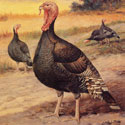
The optimal mating ratio for chickens, turkeys, and other poultry is not the same ratio in which they typically hatch. Most poultry naturally hatch approximately 50 percent females and 50 percent males. If your goal is to obtain fertile eggs for hatching, that ratio will result in males fighting excessively with each other, and when they’re not fighting they will mate excessively with the hens. The end result would be injuries all around.
The optimal number of hens available for each rooster varies from breed to breed and depends a great deal on bird size and the breed’s degree of activity. The optimal mating ratio for lightweight and extremely active Leghorn chickens, for example, is 12 to 1. For laid-back bantam Silkies, the mating ratio is 6 to 1. For heavy birds like broad breasted Bronze turkeys the mating ratio is 4 to 1. Cackle Hatchery takes the guesswork out of mating ratios by including this information in the “Breed Facts” description for each breed.
Why is the mating ratio important? If a flock includes too many males, fertility will be low because they will spend too much time fighting among themselves. When they’re not fighting they will be mating each hen too often, causing serious injuries from treading — the movements a rooster makes with his feet to keep from sliding off a hen’s back while he is attempting to mate. Excessive treading results in ripped out feathers and torn flesh. If a flock includes too few males, they will favor some hens and ignore others, resulting in uneven fertility.
Established mating ratios are not set in stone, but are little more than basic guidelines. Both an immature male and an aging male, for example, can typically handle only about half as many hens as a virile young, but fully mature male. Further, if the mating ratio for your flock calls for two males, they may spend more time sparring each other than might be the case if you had at least three males.
Another important consideration is whether or not the males are raised together. Roosters that grow up together from chicks tend to work out their differences early in life and get along fairly well thereafter. Multiple males are also more likely to get along where they have plenty of space for each to gather a harem without running into interference from the others.
Common sense should tell you that even when your flock’s mating ratio is optimal according to the guidelines, if your hens are being abused or your egg fertility is low, the situation must be analyzed and a change must be made. With chickens, one way to minimize injuries without affecting egg fertility is to let the roosters in with the hens for only one day every week or 10 days. Turkey hens will produce fertile eggs when mated during one day every two weeks or so.
Of course, how many males you keep will depend on your ultimate goal. If you just like to see roosters strutting around the yard, or you want some in your flock to protect your hens, you can get by with fewer than might be needed for egg fertility. On the other hand, if you don’t need fertilized eggs for hatching, or your zoning ordinance does not allow roosters, your hens will get along just fine with no roosters at all.
And that’s today’s news from the Cackle Coop.
Gail Damerow, author, Hatching and Brooding Your Own Chicks (Chickens, Turkeys, Ducks, Geese, Guinea Fowl)
<! — Blog –>


I ordered some Royal Palm turkeys and have been very pleased. They arrived at post office all in good health and condition. They are now 2 weeks old and doing great. Thank you very must for you quick response and excellent birds. I have raised birds for several years and tried to get some palms. You came through with great results. I will be happy to order from you again. Thank you again for your service. I live in the Lamar, MO area.
Can you mix turkey chicks with chicken chicks to make up minimum shipping.
How long, and how often, do the rooster and hen have to be together to get fertile eggs. I want to keep my “boys and girls” separate except when I want fertile eggs to set.
You might find this blog helpful: https://www.cacklehatchery.com/how-long-after-mating-does-a-hen-lay-fertile-eggs/